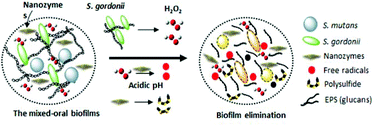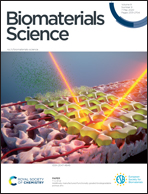Oral biofilm elimination by combining iron-based nanozymes and hydrogen peroxide-producing bacteria†
Abstract
Dental caries is a global risk in terms of oral health in many schoolchildren and in a vast majority of adults. The primary factor for caries formation is the attachment of bacteria on the tooth surface to form an oral biofilm which generates acids to demineralize calcium and eventually cause tooth decay. Oral biofilm elimination is still a challenge because bacteria are embedded inside with the biofilm matrix protecting them, preventing the penetration of antibiotics or bactericides. Promising strategies for disrupting oral biofilms have been developed, including the use of natural enzymes to degrade the biofilm matrix and hydrogen peroxide to kill bacteria. Here we demonstrate a strategy that combines nanozymes with peroxidase-like activity and bacteria generating biogenic hydrogen peroxide to eliminate oral biofilms for caries treatment. By using a saliva-coated hydroxyapatite disc and sectioned human tooth to mimic the real oral environment, we analyze the influence of iron oxide nanozymes or iron sulfide nanozymes on a Streptococcus mutans biofilm in the presence of Streptococcus gordonii which can generate hydrogen peroxide. Bacterial viability assays and biofilm morphology characterization show that the combination of nanozymes and bacteria remarkably reduces the bacteria number (5 lg reduction) and biofilm matrix (85% reduction). Therefore, the combination of iron-based nanozymes and hydrogen peroxide-generating bacteria may provide a new strategy for oral biofilm elimination in dental caries treatment.

- This article is part of the themed collection: Biomimetic Therapeutics


 Please wait while we load your content...
Please wait while we load your content...